Scleria ciliata
| Scleria ciliata | |
|---|---|

| |
| Photo by Guy Anglin, Atlas of Florida Vascular Plants | |
| Scientific classification | |
| Kingdom: | Plantae |
| Division: | Magnoliophyta – Flowering plants |
| Class: | Liliopsida – Monocotyledons |
| Order: | Cyperales |
| Family: | Cyperaceae |
| Genus: | Scleria |
| Species: | S. ciliata |
| Binomial name | |
| Scleria ciliata Michx. | |

| |
| Natural range of Scleria ciliata from USDA NRCS Plants Database. | |
Common names: Fringed nutrush, Hairy nutrush
Contents
Taxonomic notes
Synonym: Scleria ciliata Michaux var. ciliata
Variety: Scleria ciliata Michaux var. elliottii (Chapman) Fernald; Scleria ciliata Michaux var. glabra (Chapman) Fairey
Description
A description of Scleria ciliata is provided in The Flora of North America.
Distribution
Ecology
Habitat
S. ciliata can be found in longleaf pine flatwoods, upland pine forests, longleaf pine/wiregrass/scrub oak pinelands, grassy-scrub margins of depression marshes, open pinewoods, pine ridges between sloughs, longleaf pine-turkey oak sandridges and barrens, pine savannas, sandstone rock outcrops, xeric oak/saw palmetto scrubs, peaty flats bordering lakes, evergreen scrub oak sand ridges, bogs, wet hammocks, young pine plantations, moist meadows, swamp clearings, sandflats, burned old fields, burned palmetto-slashpine woodlands, and lake shores. [1] [2] [3] It can also occur in powerline corridors, open sandy chopped up fields, roadside depressions, turkey oak clearings, grassy pastures with Sarracenia flava, along highways, clearings of pine stands, edges of logging roads, shrub bog clearings, open slashpine flatwoods, mixed hardwood/cabbage palm hammocks, a bulldozed area in scrub-oak barren behind beach, clearings of slash pine flatwoods, along walking trails, and drained clearings of wet hammocks.
Soils include dry loamy sand, sand, sandy loam, and silt over clay. [2] Associated species include Sporobolus, Sporobolus junceus, Andropogon, Aristida stricta, Pinus palustris, Eleocharis, Juncus, Cyperus filiculmis, Rhynchospora, Rhynchospora glabularis, Hypericum, Liatris chapmanii, Sarracenia flava, Polygala, Rhexia, Xyris, Panicum, Stillingia aquatica, Ilex, Myrica and Drosera brevifolia. [2]
Phenology
Flowers March through September and fruits March through December. [2]
Seed dispersal
This species is thought to be dispersed by gravity. [4]
Fire ecology
Is found in recently burned longleaf pine habitats. [2] S. ciliata reached its peak abundance in 3-year rough plots, plots which had been last burned 3 growing seasons ago. [1]
Conservation and management
Cultivation and restoration
Photo Gallery
References and notes
- ↑ 1.0 1.1 Buckner, J. L. and J. L. Landers. 1979. Fire and disking effects on herbaceous food plants and seed supplies. Journal of Wildlife Management 43:807-811.
- ↑ 2.0 2.1 2.2 2.3 2.4 Florida State University Robert K. Godfrey Herbarium database. URL: http://herbarium.bio.fsu.edu. Last accessed: July 2015. Collectors: Loran C. Anderson, John B. Nelson, R. Kral, Mabel Kral, C. Jackson, Gwynn W. Ramsey, R.K. Godfrey, R. S. Mitchell, R. A. Norris, Andre F. Clewell, R. F. Doren, Helen Roth, Chris Buddenhagen, Austin Mast, Cecil R Slaughter, L. B. Smith, A. R. Hodgdon, Grady W. Reinert, J. N. Triplett, Jr., William Lindsey, George R. Cooley, Richard J. Eaton, William B. Fox, H. L. Blomquist, V. L. Cory, C. Ritchie Bell, A. E. Radford, James D. Ray, Raymond Athey, Robert F. Thorne, A. H. Curtiss, Sidney McDaniel, Richard D. Houk, Chas. C. Deam, Paul O. Schallert, Ted Bradley, John Stevenson, Edwin L. Tyson. States and Counties: Alabama: Baldwin, Houston. Florida: Bay, Calhoun, Citrus, Clay, Collier, Duval, Franklin, Gadsden, Gulf, Hernando, Indian River, Jackson, Leon, Levy, Liberty, Manatee, Orange, Osceola, Pasco, Polk, Santa Rosa, St. Johns, Suwannee, Taylor, Volusia, Wakulla, Walton, Washington. Georgia: Atkinson, Grady, Lowndes, Miller, Seminole, Tattnall, Thomas, Wayne. Kentucky: Todd. Mississippi: Lamar. North Carolina: Bladen, Brunswick, Pamlico, Pender. South Carolina: Oconee. Texas: Hardin. Virginia: Dinwiddie. Panama. Compiled by Tall Timbers Research Station and Land Conservancy.
- ↑ Jutila, H. M. and J. B. Grace. 2002. Effects of disturbance on germination and seedling establishment in a coastal prairie grassland: a test of the competitive release hypothesis. Journal of Ecology 90:291-302.
- ↑ Kirkman, L. Katherine. Unpublished database of seed dispersal mode of plants found in Coastal Plain longleaf pine-grasslands of the Jones Ecological Research Center, Georgia.